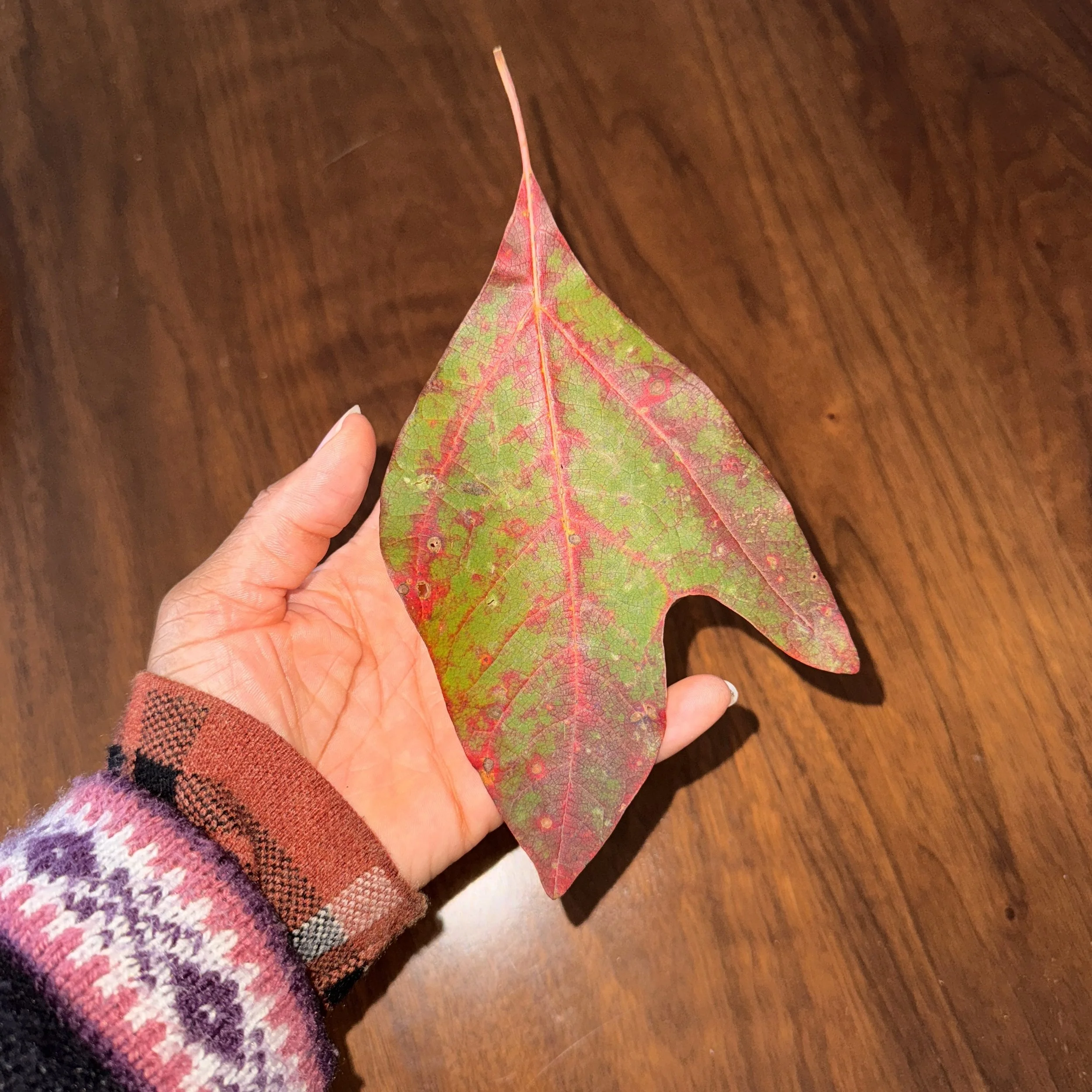Four Leaves from Sleeping Giant: A Small Collection of Autumn Stories
My Autmn Leaf Collection
In short, I left the Sleeping Giant Nature Trail in Hamden, Connecticut with four leaves. I found some vibrant unique leaves and want to share them.
I didn’t plan on collecting anything that day. I just started noticing color. In the mix of chestnut oaks, sassafras, and maples, a few leaves stood out like little colored page sheets—each colorful and different from the rest.
1. Chestnut Oak (Quercus montana)
Beautiful Orange-yellowish gradient hue
Thick, leathery, with deep teeth along the edges—this one looked tough even after falling. Chestnut oaks dominate the ridges of Sleeping Giant, where the soil is thin and rocky. According to the Sleeping Giant Park Association’s Nature Trail Guide (2019), these trees grow on drier slopes because their roots grip the stone better than most species.
The leaf I picked had already started turning from green to warm yellowish-brown, the kind of color that feels like late October. The texture was firm, sleek and shiny, like it had earned its place on a smooth dinner plate ready to eat. It reminded me of a delicious undercooked salmon dinner.
2. Sassafras (Sassafras albidum) - (the Mitten Leaf)
Mitten-shaped green body and red veins.
A few steps farther down the trail, I found its sibling—the classic sassafras shape that looks like a tiny hand waving. One side of the leaf had a “thumb” lobe, making it look half-playful, half-awkward. Sassafras trees often grow three distinct leaf shapes on the same plant: oval, mitten, and three-lobed. It’s a botanical quirk that makes identification easier once you know to look for it.
This mitten-shaped leaf was a soft amber color with touches of green left throughout the leaf body. When I held it up, it caught the light like stained glass. I crushed the stem lightly and got that faint root-beer smell—thanks to a compound called safrole. The leaf also looks like it’s bleeding.
There’s something cozy about that mitten shape: each leaf unique, but connected to the same tree. A reminder that variety isn’t chaos—it’s design.
3. Sassafras (the Red Leaf)
Perfectly vibrant red colored autumn leaf
The second sassafras leaf I found was a deep reddish-orange—broad and simple, shaped like a teardrop with pointed ends. It didn’t have the “mitten” shape sassafras is famous for, just a clean, symmetrical form.
Sassafras leaves turn some of the richest colors in eastern forests when autumn hits, from gold to coral to crimson. According to the Native Plant Trust’s Go Botany database, sassafras trees grow in open, sunny spaces and can quickly reclaim disturbed land. They’re early settlers of a forest, preparing the ground for others.
This red leaf looked like it knew it was temporary, and it didn’t mind. The color was its way of saying goodbye before the frost.
4. The Unknown Yellow-Centered Leaf
Yellow-centered, red coated leaf
This one’s a mystery. Brownish-red edges fading into a golden center, like a watercolor done by chance. The veins ran evenly, the tip slightly pointed, but it didn’t match any species I could easily name.
I could have spent an hour flipping through field guides trying to identify it, but I didn’t. Some things don’t need to be labeled to be appreciated. Maybe it was a stressed maple or a hybrid sapling from the lower slope. Or maybe it was just one of those one-off leaves that show how much variation exists even within a single species.
What mattered was how it caught the sunlight—like it had its own small story to tell, even if I never figure it out.
What These Four Leaves Have in Common
They’re small proof that nature doesn’t repeat itself. Each leaf carries a slightly different version of the same season, the same forest, the same air. Together, they tell a story of the mountain’s layers—dry ridges, shady valleys, open patches where new trees claim their space.
A lot of hikers collect peaks. I guess I collect moments. These four leaves—oak, sassafras, quince, and the mystery one—aren’t rare or exotic. They’re just honest. Each one says something about adaptation, survival, and change.
When I look at them now, pressed flat and brittle, I think about how they looked before I picked them up—still moving in the breeze, still part of something bigger. That’s the quiet beauty of field collecting: you take a tiny piece of a living system, not as a trophy, but as a reminder that you were paying attention.
And that’s really all nature ever asks of us.
Call to ACTION!
“Have you been on a hike in a seasonal location? What leaves have you found that are notable and vibrant? Could you easily identify them? How do you normally identify leaves and plants?”






